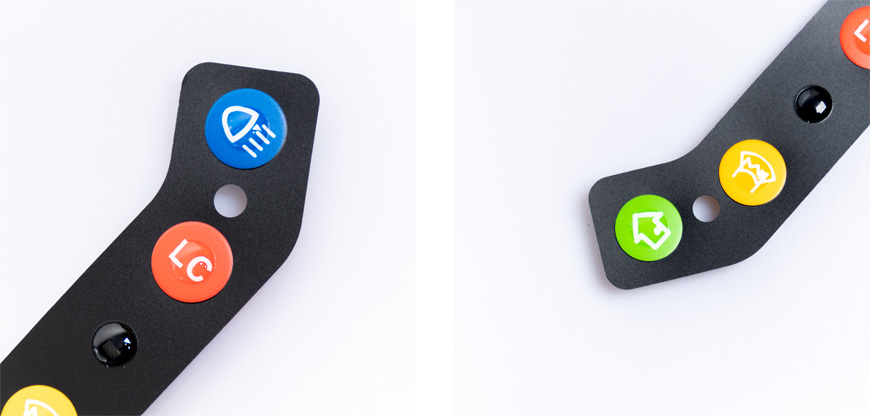
In today's rapidly evolving technological landscape, user interfaces play a pivotal role in enhancing user experience and functionality. One such innovation is the embossed membrane switch, a versatile and reliable component found in various devices and equipment. In this comprehensive guide, we'll delve into the world of embossed membrane switches, exploring their design, applications, benefits, and more.

1. Introduction
2. What Is an Embossed Membrane Switch?
Structure and Components
3. How Do Embossed Membrane Switches Work?
4. Applications Across Industries
Medical Devices
Industrial Control Panels
Consumer Electronics
5. Advantages of Using Embossed Membrane Switches
6. Design Considerations
Material Selection
Customization Options
7. Ensuring Durability and Longevity
8. Maintenance and Cleaning
9. Comparing Embossed Membrane Switches with Other User Interfaces
Membrane vs. Mechanical Keyboards
Touch Screens vs. Membrane Switches
10. Future Trends in Membrane Switch Technology
11. Selecting the Right Embossed Membrane Switch Manufacturer
12. Installation and Integration
13. Cost-Effectiveness and ROI
14. Challenges and Limitations
15. Conclusion
In a world driven by technology, the importance of user interfaces cannot be overstated. From touch screens to tactile buttons, these interfaces bridge the gap between humans and machines. One remarkable innovation in this domain is the embossed membrane switch.
Structure and Components
An embossed membrane switch is a user interface device typically composed of several layers of flexible materials. These layers include graphic overlays, adhesive spacers, and circuitry layers. The graphic overlay is the topmost layer, featuring embossed or raised buttons that users press to activate various functions.
Embarking on a deeper dive into their functionality, these switches work by using a simple yet effective principle. When a user applies pressure to a raised button on the graphic overlay, it compresses the spacer layer beneath, causing it to make contact with the circuitry layer. This contact triggers the desired action, such as turning on a device or inputting a command.
Embossed membrane switches find applications across a wide range of industries due to their versatility and reliability.
Medical Devices
In the medical field, these switches are used in various equipment, including diagnostic devices, patient monitoring systems, and medical instruments. Their sealed and easy-to-clean design makes them ideal for healthcare settings.
Industrial Control Panels
Industrial control panels often require durable and resistant user interfaces. Embossed membrane switches excel in these environments, withstanding harsh conditions and ensuring consistent performance.
Consumer Electronics
From microwave ovens to remote controls, consumer electronics benefit from the sleek and user-friendly design of embossed membrane switches. They provide responsive input without compromising aesthetics.
The adoption of embossed membrane switches offers several key advantages:
Durability and Longevity
Customization Options
Compact Design
Tactile Feedback
Resistance to Environmental Factors
Material Selection
Choosing the right materials for your membrane switch is crucial. Factors like flexibility, resistance to wear and tear, and environmental considerations must be taken into account during the design phase.
Customization Options
Embossed membrane switches can be customized to meet specific design and branding requirements. Custom graphics, colors, and button shapes can enhance the user experience.
To maximize the lifespan of your membrane switch, proper design and manufacturing techniques must be employed. Ensuring that it can withstand the rigors of its intended application is paramount.
One of the advantages of embossed membrane switches is their ease of maintenance. Regular cleaning with mild solutions can keep them in optimal condition for years.
Membrane vs. Mechanical Keyboards
While membrane keyboards are known for their quiet operation, mechanical keyboards offer a distinct tactile feel. The choice between the two depends on user preferences and specific use cases.
Touch Screens vs. Membrane Switches
Touch screens provide a visually appealing interface, but embossed membrane switches offer physical feedback, making them suitable for applications where tactile input is essential.
As technology advances, so does the design and functionality of membrane switches. Innovations such as capacitive touch and haptic feedback are expected to shape the future of user interfaces.
Choosing a reputable manufacturer is crucial to ensure the quality and performance of your membrane switches. Look for companies with a track record of delivering reliable solutions.
Proper installation and integration are key to ensuring that your embossed membrane switch functions seamlessly within your device or equipment.
Despite their initial investment, embossed membrane switches often prove cost-effective in the long run due to their durability and low maintenance requirements.
While embossed membrane switches offer numerous benefits, they are not without challenges, such as limited tactile feedback compared to mechanical switches and potential issues with extreme temperatures.
In conclusion, embossed membrane switches are a remarkable innovation in user interface technology. Their versatility, durability, and customizability make them a preferred choice across various industries. As technology continues to evolve, these switches will likely play an even more significant role in enhancing user experiences.
Are embossed membrane switches easy to clean?
Yes, these switches are easy to clean with mild cleaning solutions, making them suitable for applications where hygiene is essential.
What is the lifespan of an embossed membrane switch?
The lifespan of a membrane switch depends on factors such as design, materials, and usage. However, with proper design and maintenance, they can last for many years.
Can embossed membrane switches be customized with specific graphics and colors?
Absolutely, embossed membrane switches can be customized with graphics, colors, and button shapes to align with branding and design requirements.
Are there any limitations to using embossed membrane switches?
While they offer numerous benefits, embossed membrane switches may have limited tactile feedback compared to mechanical switches and may not perform well in extreme temperature conditions.
How do I select the right embossed membrane switch manufacturer for my project?
It's essential to research and choose a reputable manufacturer with a history of delivering high-quality, reliable membrane switches that meet your project's requirements.